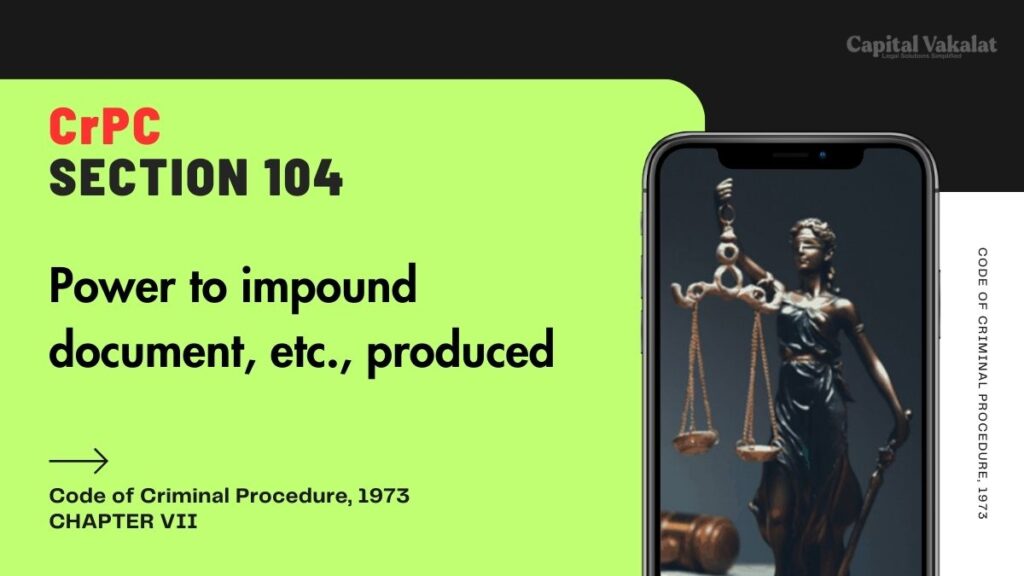Section 104 of the Code of Criminal Procedure (CrPC) empowers authorities to impound any document or thing produced before the court. This section is critical in legal procedures, ensuring that necessary evidence is preserved and examined properly.

In this article, we delve deep into the intricacies of Section 104 CrPC, its applications, and its significance in the judicial process.
Bare Act. Section 104 Cr.P.C.
Power to impound document, etc., produced.
Any Court may, if it thinks fit, impound any document or thing produced before it under this Code.
What is Section 104 CrPC?
Section 104 of the CrPC provides the legal framework allowing courts to impound documents or things produced before them. This power is instrumental in maintaining the integrity of evidence and ensuring fair proceedings. When a document or object is impounded, it is taken into custody by the court and may be subjected to further scrutiny or examination as deemed necessary by the judicial authorities.
The Significance of Section 104 CrPC
The authority to impound documents is vital for several reasons. It helps in:
- Preserving Evidence: By impounding documents, the court ensures that evidence remains unaltered and intact.
- Preventing Tampering: Impounding helps prevent any tampering or destruction of evidence that could compromise the judicial process.
- Facilitating Fair Trials: By safeguarding crucial evidence, the court can ensure a fair trial, maintaining the integrity of the judicial process.
When Can Section 104 CrPC be Invoked?
Section 104 CrPC can be invoked under circumstances where the court deems it necessary to impound documents to:
- Protect the authenticity of the evidence.
- Prevent interference with the judicial process.
- Ensure that justice is served without any hindrances or manipulation of evidence.
Procedural Aspects of Section 104 CrPC
The procedure to impound a document or object involves several steps:
- Production of Evidence: The document or object must first be produced before the court.
- Court’s Decision: The court then evaluates the necessity of impounding the item.
- Impounding Order: If deemed necessary, the court issues an order to impound the document or object.
- Custody of Impounded Items: The impounded items are taken into judicial custody and safeguarded until further orders.
Legal Implications of Impounding Documents
Impounding documents can have significant legal implications, such as:
- Impact on Trials: Impounded evidence is crucial in the trial process and can influence the outcome.
- Rights of the Parties: The parties involved have the right to challenge the impounding order if they believe it to be unjustified.
- Judicial Review: Orders under Section 104 can be subject to judicial review to ensure fairness and legality.
Case Studies Involving Section 104 CrPC
Several landmark cases have highlighted the application and importance of Section 104 CrPC. For instance:
- Case A: In this case, the court impounded crucial financial documents that were pivotal in uncovering fraudulent activities.
- Case B: The impounding of communication records in a high-profile case helped in preserving key evidence that was later used to convict the accused.
Challenges and Criticisms of Section 104 CrPC
Despite its importance, Section 104 CrPC faces certain challenges and criticisms:
- Potential for Misuse: There is a risk of the power being misused to harass individuals or delay proceedings.
- Rights of the Accused: The accused may feel their rights are infringed upon if documents crucial to their defense are impounded.
Reforms and Recommendations
To address these challenges, several reforms and recommendations have been proposed:
- Clear Guidelines: Establishing clear guidelines on the application of Section 104 to prevent misuse.
- Judicial Oversight: Strengthening judicial oversight to ensure that impounding orders are fair and justified.
- Protecting Rights: Ensuring that the rights of all parties are protected, and there is a balance between preserving evidence and safeguarding individual rights.
Conclusion
Section 104 CrPC plays a pivotal role in the judicial process by empowering courts to impound documents and objects produced before them. This power is essential for preserving the integrity of evidence, preventing tampering, and ensuring fair trials. However, it is crucial to address the challenges and criticisms associated with this section through reforms and judicial oversight. By doing so, the legal system can strike a balance between preserving evidence and protecting the rights of all parties involved, thus upholding the principles of justice and fairness.
Frequently Asked Questions
How does Section 104 CrPC prevent tampering of evidence?
By impounding documents or objects, the court takes them into custody, preventing any tampering, alteration, or destruction, thus maintaining their authenticity.
Can the impounding order under Section 104 CrPC be challenged?
Yes, parties involved have the right to challenge the impounding order if they believe it to be unjustified, and such orders can be subject to judicial review.
What are the procedural steps for impounding a document under Section 104 CrPC?
The procedural steps include the production of evidence before the court, the court’s evaluation, issuing an impounding order, and taking the impounded items into judicial custody.
Are there any criticisms of Section 104 CrPC?
Yes, criticisms include the potential for misuse of power, infringement on the rights of the accused, and possible delays in legal proceedings.
What reforms are suggested for Section 104 CrPC?
Reforms include establishing clear guidelines, strengthening judicial oversight, and ensuring a balance between preserving evidence and protecting individual rights.